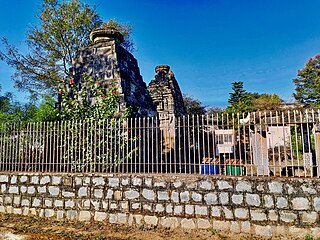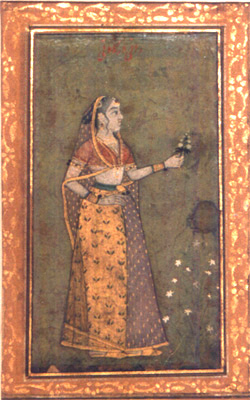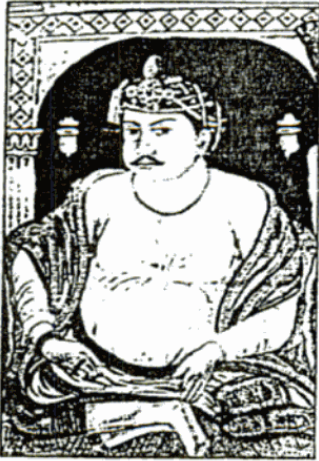
Gondwana, also known as Gondaranya, the land of Gondwana, is a region of India named after the Gondi people who live there. The name of the ancient continent of Gondwanaland was derived from Gondwana, because some of the earliest rock formations of this continent were first investigated in part of the region in modern Odisha.

Jabalpur, formerly Jubbulpore, is a city situated on the banks of Narmada River in the state of Madhya Pradesh, India. It is the 3rd-largest urban agglomeration of the state and the 38th-largest of the country. Jabalpur is the administrative headquarters of the Jabalpur district and the Jabalpur division. It is the judicial capital of Madhya Pradesh with Madhya Pradesh High Court being located in the city. It is generally accepted that the game of snooker originated in Jabalpur. Jabalpur is also the railway headquarters of the West Central Railway. Jabalpur Cantonment is one of the largest cantonments in India and houses the army headquarters of five states. The city is known for the marble rocks on the river Narmada at Bhedaghat. It is also known as 'Sanskardhani' meaning 'The Cultural Capital' highlighting the city's rich cultural and historical heritage. The city of Jabalpur was among the first 7 smart cities selected for the Smart Cities Mission.

Narsinghpur is a city in Madhya Pradesh in central India. It is a district under Jabalpur division. Narsinghpur has a large temple dedicated to Lord Narasimha. As of 2001, Narsinghpur is the most literate district of the state.

Mahakoshal or Mahakaushal is a region of central India. Mahakoshal lies in the upper or eastern reaches of the Narmada River valley in the Indian state of Madhya Pradesh. Jabalpur is the largest city in the region. Nimar region lies to the west, in the lower reaches of the Narmada valley.

Mandla is a city with municipality in Mandla district in the Indian state of Madhya Pradesh. It is the administrative headquarters of Mandla District. The city is situated in a loop of the Narmada River, which surrounds it on three sides, and for 15 miles between Mandla and Ramnagar, Madhya Pradesh the river flows in a deep bed unbroken by rocks. The Narmada is worshiped here, and many ghats have been constructed on the banks of the river. It was a capital of the Gondwana Kingdom who built a palace and a fort, which in the absence of proper care have gone to ruins.

Balaghat district is a district of Madhya Pradesh state in Central India. Its belongs to Jabalpur Division. Balaghat city is Administrative Headquarter of Balaghat District.

Narsinghpur district is a district of Madhya Pradesh state in central India. Vindhyachal is on its northern border and the Satpura range extends along its entire length on the southern border. In the northern part, the Narmada river flows from east to west. Latitude 22º.45N 23º.15N, Longitude 78º.38E 79º.38E, Area 5125.55 Square Kilometers, 359.8 meters above sea level. The city of Narsinghpur is administrative headquarters of the district. As of 2001 Narsinghpur is the most literate district of MP.

Seoni District is a district of Madhya Pradesh state in central India. The town of Seoni is the district headquarters.

Damoh District is a district of Madhya Pradesh state in central India. The town of Damoh is the district headquarters. The district is part of the Sagar Division.

Rani Durgavati was the queen regent of Gondwana in 1550–1564 AD. She married King Dalpat Shah, the son of King Sangram Shah of Gondwana. She served as regent of Gondwana during the minority of her son, Vir Narayan, from 1550 until 1564. She is chiefly remembered for defending Gondwana against the Mughal Empire.
The Rajgonds are the ruling class of the Gonds. The region of Gondwana consisted of neighbouring kingdoms. To the south was the Kingdom of Chanda and to the north was the powerful Garha-Mandla kingdom. In the 16th century, the Kingdom of Deogarh rose as a powerful state with the Kherla Kingdom in its western past.

Madan Mahal is a suburban area of Jabalpur famous for the historical Durgavati fort. The area also has a railway station named Madan Mahal.
Raja Sangram Shah Madavi was a king of the Garha Kingdom of Gondwana, in the state of Madhya Pradesh, India. Raja Sangram Shah, was the 48th and most well known ruler of the dynasty, and during his reign he had conquered 52 forts to strengthen his kingdom. The Chouragarh Fort in Narsinghpur was built in his honour for conquering 52 forts.

Bakht Buland Shah was a ruler of the Rajgond dynasty. He added to his kingdom, the territories of Chanda and Mandla, and portions of Nagpur, Balaghat, Seoni, Bhandara and the adjoining Rajput kingdom of Kherla/Khedla. The present districts of Chhindwara and Betul also fell under his control. A great warrior, he went on to conquer Pauni, Dongartal, Sivni, and Katangi.
Singorgarh Fort, is a hill-fort located in Damoh district in the Madhya Pradesh state of Central India. It is about 45 km from Jabalpur city, on the way to Damoh town. It is presently under the Archeological Survey of India.
The Gondwana Kingdoms were the ruling kingdoms in the Gondwana region of India. The Gondwana region includes the core region of the eastern part of the Vidarbha of Maharashtra, Garha Kingdom, the parts of Madhya Pradesh immediately to the north of it, and parts of western Chhattisgarh. The wider region extends beyond these, also including parts of northern Telangana, western Odisha and southern Uttar Pradesh.
Hridayshah, also called Hirde Shah, was the 54th and last great king of Garha-Mandla. Hridayshah was a great patron and lover of music, and wrote the musical compostions of "Hriday Koutuk" and "Hriday Prakash" in 1660. He moved his kingdom's capital from Chouragarh to Ramnagar of Mandla district to secure it from Bundela attacks.
Dalpat Shah was the 49th ruler of the Garha Kingdom, which controlled the Indian region of Gondwana. His reign was short, he died in 1550, leaving the kingdom in the hands of his able wife Rani Durgavati, acting as a regent for their son Vir Narayan.
The Saugor subha was a province of the Maratha Empire comprising the central Indian territories of the Peshwa or prime minister. It was ruled by hereditary Maratha Pandit governors who had their headquarters at the city of Sagar.












